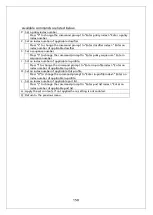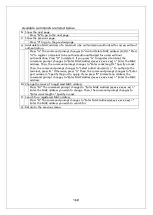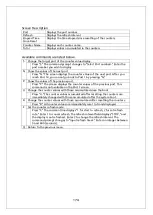
162
Available commands are listed below.
F Set Default VLAN ID.
Press "F." The command prompt changes to "Enter default VLAN ID>." Enter an
integer between 1 and 4094. Enter 0 to disable the Default VLAN function.
T Set the interval time to reattempt of authentication.
Press "T." The command prompt changes to "Enter Transmission Period>." Enter an
integer between 1 and 65535 (seconds).
U Set the period time to wait before reattempting a failed authentication.
Press "U." The command prompt changes to "Enter Quiet Period>." Enter an
integer between 1 and 65535 (seconds).
X Set the maximum number of reattempts of authentication.
Press "X." The command prompt changes to "Enter Max request count>." Enter the
maximum number of reattempts with an integer between 1 and 10.
O Set timeout for the authentication server.
Press "O." The command prompt changes to "Enter Server Timeout>." Enter an
integer between 1 and 65535 (seconds).
L Set the timeout for the client
Press "L." The command prompt changes to "Enter Supplicant Timeout value>."
Enter an integer between 1 and 65535 (seconds).
S Set the Guest Access application conditions.
Press "S." The command prompt changes to "Select the guest access mode (T/B/A)
>." Press "T" to select Supplicant Timeout, "A" to select Auth Fail, or "B" for both.
G Specify a VLAN to be assigned when a terminal that failed authentication or that does
not have a supplicant is connected.
Press "G." The command prompt changes to "Enter guest VLAN ID >." Enter an
integer between 1 and 4094. Enter 0 to disable the Guest Access function.
Y Enable/disable the dynamic VLAN function.
Press "Y." The command prompt changes to "Enable or Disable dynamic VLAN
status? (E/D) >." Press "E" to enable the dynamic VLAN function. Press "D" to
disable it.
E Set the periodic re-authentication time interval.
Press "E." The command prompt changes to "Enter re-authentication Period>."
Enter an integer between 1 and 65535 (seconds).
A Enable/disable periodic re-authentication.
Press "A." The command prompt changes to "Enable or Disable re-authentication?
(E/D)>." Press "E" to enable re-authentication. Press "D" to disable it.
Z Initialize the authentication status.
Press "Z." The command prompt changes to "Would you initialize
authenticator?(Y/N)>." To initialize it, press "Y." Otherwise, press "N."
R Initialize the re-authentication status.
Press "R." The command prompt changes to "Would you want to initialize
re-authenticator?(Y/N)>." To initialize it, press "Y." Otherwise, press "N."
H Not available for Port Based mode
I Not available for Port Based mode
Q Return to the previous menu.
Note: Our switches assign a VLAN ID in reference to the value of Attribute
81 (Tunnel Private Group Id) included in RADIUS packets from the
RADIUS server.
Summary of Contents for Switch-M12PWR
Page 17: ...17 Fig 2 2 Mounting to Wall ...
Page 20: ...20 function does not work Therefore use a cross cable to connect them ...
Page 30: ...30 ...
Page 36: ...36 ...
Page 49: ...49 ...
Page 69: ...69 ...
Page 81: ...81 setting and the management VLAN status of VLAN ID 1 is UP ...
Page 96: ...96 Press S Q Return to the previous menu ...
Page 98: ...98 ...
Page 122: ...122 Q Return to the previous menu ...
Page 125: ...125 ...
Page 130: ...130 ICMP Type Displays the ICMP type ...
Page 156: ...156 Threshold Displays the threshold of the number of packets per second ...
Page 173: ...173 Fig 4 7 49 Display of values accumulated after resetting the counters ...
Page 185: ...185 Q Return to the previous menu ...
Page 211: ...211 Q Return to the previous menu ...
Page 232: ...232 IEEE8021 PAE MIB IEEE802 1X IEEE8023 LAG MIB IEEE 802 3ad ...
Page 237: ...237 IEEE 802 3af standard ...
Page 240: ...240 P0813 1084 ...
















































